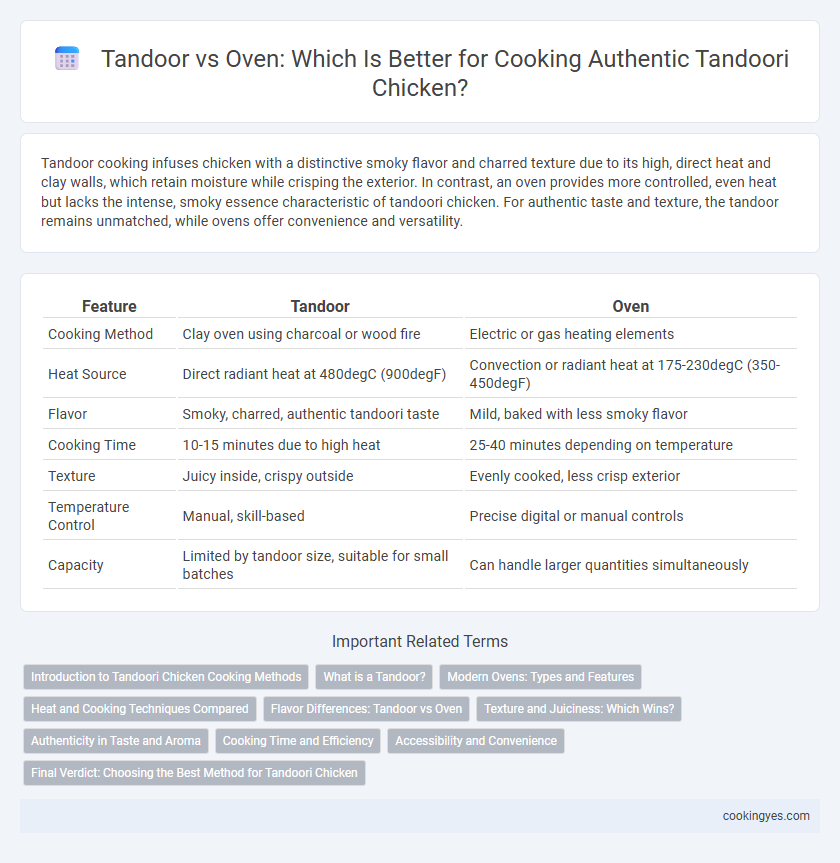Tandoor cooking infuses chicken with a distinctive smoky flavor and charred texture due to its high, direct heat and clay walls, which retain moisture while crisping the exterior. In contrast, an oven provides more controlled, even heat but lacks the intense, smoky essence characteristic of tandoori chicken. For authentic taste and texture, the tandoor remains unmatched, while ovens offer convenience and versatility.
Table of Comparison
| Feature | Tandoor | Oven |
|---|---|---|
| Cooking Method | Clay oven using charcoal or wood fire | Electric or gas heating elements |
| Heat Source | Direct radiant heat at 480degC (900degF) | Convection or radiant heat at 175-230degC (350-450degF) |
| Flavor | Smoky, charred, authentic tandoori taste | Mild, baked with less smoky flavor |
| Cooking Time | 10-15 minutes due to high heat | 25-40 minutes depending on temperature |
| Texture | Juicy inside, crispy outside | Evenly cooked, less crisp exterior |
| Temperature Control | Manual, skill-based | Precise digital or manual controls |
| Capacity | Limited by tandoor size, suitable for small batches | Can handle larger quantities simultaneously |
Introduction to Tandoori Chicken Cooking Methods
Tandoori chicken cooking involves high-heat methods that deeply infuse smoky flavors and crisp textures, traditionally achieved using a clay tandoor oven heated by charcoal or wood. Compared to conventional ovens, tandoors generate intense radiant heat reaching up to 900degF, enhancing the marinade's spices and creating a signature charred exterior. While ovens offer controlled temperatures and convenience, the tandoor's unique combustion and air circulation contribute to the authentic taste and texture that define classic Tandoori chicken.
What is a Tandoor?
A tandoor is a traditional clay oven originating from South Asia, designed to cook food using radiant heat from charcoal or wood fires at extremely high temperatures, often exceeding 480degC (900degF). This unique cooking method imparts a distinct smoky flavor and creates a crispy exterior while keeping chicken tender and juicy inside. Unlike conventional ovens that rely on air circulation, a tandoor's intense direct heat and enclosed environment produce characteristic char and texture, making it ideal for authentic tandoori chicken.
Modern Ovens: Types and Features
Modern ovens, including convection and electric models, offer precise temperature control and even heat distribution ideal for cooking chicken. Unlike tandoors that use charcoal or wood for smoky, high-heat cooking, convection ovens utilize fans to circulate hot air, enhancing crispiness while retaining juiciness. Features such as preset cooking modes, timer functions, and adjustable racks provide versatility and convenience for preparing tandoori-style chicken with consistent results.
Heat and Cooking Techniques Compared
Tandoor ovens use intense radiant heat from charcoal or wood at temperatures reaching 480-500degC, creating a smoky flavor and crispy exterior on chicken through direct exposure to high heat. Conventional ovens rely on convection heat with more evenly distributed temperatures around 175-250degC, resulting in slower cooking and less charred texture. The vertical design of the tandoor ensures rapid moisture retention and searing, while ovens provide consistent but less intense heat, impacting the final tenderness and flavor profile of the chicken.
Flavor Differences: Tandoor vs Oven
Chicken cooked in a tandoor develops a distinctive smoky aroma and charred flavor due to the intense radiant heat from charcoal or wood, which penetrates the meat quickly, sealing juices and enhancing natural spices. Oven baking lacks the intense, direct heat and smoke, resulting in a milder, less smoky flavor profile with more even cooking but less caramelization and depth. The tandoor's unique clay chamber environment imparts a rich, complex taste that is difficult to replicate with conventional ovens.
Texture and Juiciness: Which Wins?
Tandoori chicken boasts a unique texture and juiciness due to the intense, radiant heat of the tandoor, which locks in moisture while creating a crispy, charred exterior. In contrast, oven-baked chicken tends to cook more evenly but often lacks the smoky flavor and crispness, resulting in a less vibrant texture. The tandoor's high temperature sears the chicken quickly, preserving juiciness, making it the preferred method for achieving succulent, flavorful meat.
Authenticity in Taste and Aroma
Chicken cooked in a tandoor achieves a distinctive smoky flavor and charred aroma that an oven cannot replicate due to its charcoal or wood firing method, which imparts authentic Indian culinary qualities. The high heat and open flame environment inside a tandoor evenly cooks the chicken while sealing in natural juices, enhancing both taste and tenderness. In contrast, conventional ovens lack this intense, direct heat source, resulting in a milder flavor profile and less pronounced aroma, making the tandoor the preferred method for genuine Tandoori chicken.
Cooking Time and Efficiency
Tandoor cooking significantly reduces chicken cooking time by using intense radiant heat at temperatures reaching 900degF (482degC), enabling faster and more even cooking compared to conventional ovens that average around 375-450degF (190-232degC). The tandoor's clay chamber retains heat efficiently, creating a unique smoky flavor while minimizing energy consumption. In contrast, ovens require longer preheating and cooking durations, leading to higher overall energy use and less moisture retention in the chicken.
Accessibility and Convenience
Tandoor offers authentic flavor and high heat cooking, but requires specialized equipment and outdoor space, limiting accessibility for many home cooks. Conventional ovens are widely available in most kitchens, providing convenience with adjustable temperature controls and easier maintenance. For everyday use, ovens present a more practical option, while tandoors remain ideal for traditional, smoky taste when accessible.
Final Verdict: Choosing the Best Method for Tandoori Chicken
Tandoori chicken cooked in a tandoor develops a unique smoky flavor and retains juiciness due to the high, direct heat and clay environment. Oven cooking offers convenience and precise temperature control but lacks the authentic char and aroma characteristic of traditional tandoori preparation. For the best balance of flavor, texture, and authenticity, the tandoor remains the superior method for cooking tandoori chicken.
Tandoor vs Oven for chicken Infographic

 cookingyes.com
cookingyes.com